FROM THE DAWN OF HISTORY TO A BORDER PROVINCE
Today's Republic of Austria is a small country located in the center
of Europe. The origins of present-day Austria can be traced far back
into history. The country has been populated since pre-historic times,
and numerous peoples have passed through it. As a nation at the heart of
Europe, Austria has had its full share of the continent's history,
including the suffering. Over the centuries it developed from a border
region into a powerful empire and a multinational entity which collapsed
at the end of the First World War.
From the emergence of the border province until the distintegration of
the empire, Austria was ruled by two dynasties: the Babenbergs and the
Habsburgs. After the First World War the newly proclaimed small Republic
of Austria was called upon to come to terms with its European
environment. Austria emerged from the Second World War and the anguish
associated with it as a nation that feels secure in its existence and is
aware of its role in Europe.
HOME OF THE ILLYRIANS AND THE CELTS
The first traces of settlements in sheltered areas at a high altitude
date back to the Palaeolithic Age. The Danube area was settled between
80,000 and 10,000 B.C. The "Tänzerin" and the "Venus
of Willendorf" from the Krems area provide the first evidence of
early cultures. In the Neolithic period these early inhabitants already
practised crop and livestock farming and used tools made of metal. In
1991 the sensational discovery of a mummified male body dating from the
Stone Age was made in the glacial ice of the Ötztal Alps.
In the early Iron Age, between about 800 and 400 B.C., the Indo-European
Illyrians lived on the territory now covered by Austria. They traded
widely, mainly in salt and ores. This Hallstatt civilization, named
after the most important site of their culture, was spread further by
the Celts, who maintained trade relations all over Europe. This people,
which had migrated from Western Europe, established tightly organized
principalities. Salt and the high-quality Noric iron mined at the
Styrian Erzberg continued to form the economic mainstay of their power.
AUSTRIA ROMANA
| The Roman Empire, which had for a
long time been a trading partner of the Noric kings and princes,
conquered the greater part of present-day Austria around the
time of Christ. The conquered areas were incorporated into the
Roman Empire and divided into the provinces of Rhaetia, Noricum
and Pannonia. As border areas of the Roman Empire, these
provinces were of great significance. During this period the
Romans founded numerous settlements on Austrian territory, such
as Vindobona (= Vienna), Iuvavum (= Salzburg) or Brigantium (=
Bregenz). |
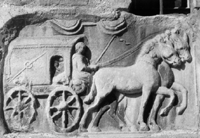
Roman stage coach on a relief stone in the
pilgrimage church of Maria Saal, Carinthia
|
|
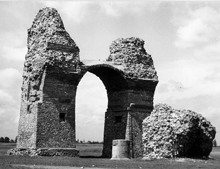 Carnuntum,
Remains of the city gate Carnuntum,
Remains of the city gate
|
Carnuntum in Pannonia, situated east of Vienna, was the
largest Roman town on Austrian soil. During its heyday Carnuntum
had about 20,000 inhabitants. The Romans brought their
civilization, their religion and their system of administration
to these provinces. In the second century A.D., Christianity
began to spread on Austrian territory as well. |
THE TRIBAL MIGRATIONS
The decline of Roman power, which was threatened by the influx of
peoples from the East, went hand in hand with a weakening of Roman rule
in this region. Germanic tribes infiltrated from beyond the borders, and
with the downfall of the Roman Empire the Roman way of life and culture
disappeared from this area as well. During the following era of mass
migration, various tribes passed through the territory covered by the
Austria of today, leaving the country devastated. From the 6th century
onwards continuous settlement of the area started again, this time by
the Bavarians who met with the Slavs and the Avars advancing from the
East. In numerous battles the Bavarians succeeded in firmly establishing
themselves. They were a people of crop farmers and settled in rural
areas. The towns dating from the Roman era fell into decay during this
period. The ecclesiastical organisation of the country dates from the
4th century. The bishoprics of Passau, Regensburg and Salzburg made an
important contribution to the further settlement of the country.
CAROLINGIAN AND OTTONIAN BORDER PROVINCE
The Frankish ruler Charlemagne, after his victory over the Avars,
established a system of border protectorates. For this purpose he
founded the Carolingian border province between the river Enns, Raab and
Drau. At the end of the 9th century the Magyars encroached upon Austrian
territory and inflicted a devastating defeat upon the Bavarian forces
"apud Weniam" (= near Vienna). The border province crumbled:
it was not until 995 that Otto the Great succeeded in defeating the
Magyars and re-conquering the area. Around 970 the "Karantanische
Mark" (Carantanian Province) under the administration of the
Eppenstein dynasty was founded as an autonomous area. In 976 Leopold von
Babenberg, descendant of a noble Bavarian family, was made the ruler of
the area between the Enns and the Traisen.
¡@
RULE OF THE BABENBERGS
MARGRAVIATE OF AUSTRIA
It is possible that the new ruler of this area resided in Melk. Later
on, however, the Babenbergs moved their residence further eastwards; in
1156 Duke Heinrich II ("Jasomirgott") chose Vienna as his
definitive residence. The Babenberg rulers succeeded in gradually
expanding their sphere of influence. They extended their possessions to
the North of the Danube and further to the East and South. Before the
turn of the millennium (996) a document referred to the region of the
Alpine foothills under its present name "Österreich"
("ostarrichi" = Austria). The further settlement and
colonization of the country was completed around 1200. The monasteries
and abbeys founded by the Babenbergs played an important role in this
process and soon also became centers of cultural life.
AUSTRIA BECOMES A DUCHY
| In 1156 the Babenbergs who, since the marriage of
Leopold III to the emperor's widow Agnes, had ranked among the
most powerful families in the empire, secured the transformation
of the margraviate into a duchy by Emperor Friedrich Barbarossa.
The document is known as "Privilegium minus" and
contains significant concession allowing for greater
independence from the imperial power. |

Saint Rupert baptising heathens: miniature
from the antiphonary of St. Peter in Salzburg, dating from 1160
|
In the course of the investiture conflict which smouldered in the
Holy Roman Empire, the Babenbergs sided with the emperor; as a reward
for their loyalty they received the western Mühlviertel from
Bavaria. In 1192 the Babenberg Leopold V obtained the Duchy of Styria
through inheritance. Moreover, he took part in the crusade and excelled
in the battle of Akko. In 1192 Leopold V imprisoned his rival, the
English king Richard the Lionhearted, and released him only on payment
of a high ransom which was used to fortify the towns of Wiener Neustadt
and Vienna. ]
In the first half of the 13th century cultural life at the court of the
Babenbergs was in full bloom. Minstrels such as Walther von der
Vogelweide and Ulrich von Liechtenstein wrote their songs. Romanesque
architecture came to a late fruition.
THE INTERREGNUM
In 1246 the childless Duke Friedrich II died in the battle of the Leitha
River against the Magyars. After his death his lands became the object
of their neighbors' power politics. Eventually the Austrian nobility
sided with the Bohemian king Ottokar II Przemysl, who secured the
heritage for himself by marrying the last Babenberg's sister. He quickly
succeeded in establishing order in the country, in re-conquering Styria
and in taking over Carinthia through a contract of inheritance. His
sphere of influence extended from the Sudeten mountains to the Adriatic
Sea. The Holy Roman Empire's newly elected king, Rudolf of Habsburg,
however, was not prepared to recognize the Bohemian king's power.
Ottokar refused to swear an oath of allegiance and was placed under the
ban of the Empire. He still had many supporters, and eventually the two
sides resorted to arms. Ottokar was killed in the battle of Dürnkrut
in 1278. The Babenberg lands were occupied by Rudolf von Habsburg.
In 1282 Rudolf enfeoffed his two sons with the Duchies of Austria and
Styria, thus laying the foundations for Habsburg dynastic power.
¡@
600 YEARS OF HABSBURG RULE
THE ESTABLISHING OF DYNASTIC POWER
|
 Portrait
of the founder of the University of Vienna, Duke Rudolf
IV of Austria, around 1363
Portrait
of the founder of the University of Vienna, Duke Rudolf
IV of Austria, around 1363
|
At the beginning, however, the Habsburgs' position was far
from secure. Again and again there were revolts, and even the
Swiss cantons, which had earlier been part of the Habsburg
possessions, launched an armed rebellion. The Habsburgs were
defeated in the battle of Morgarten and thus lost these areas.
When the gifted Rudolf IV, known as the Founder, felt that he
and his family had been passed over by the Golden Bull of the
Luxembourg Emperor Karl IV, he forged several documents which
went down in history as the "Privilegium maius" to
attest to his dynasty's higher rank. It was his descendant
Emperor Friedrich III who asserted the claims made in these
documents. Rudolf's short rule (1358-1365) was marked by the
acquisition of the Earldom of Tyrol and parts of the "Windische
Mark". He founded the Unversity of Vienna and commissioned
the enlargement of St. Stephen's in Vienna into a Gothic
cathedral, thus also creating an important cultural heritage. |
The partitions and family feuds of the next few decades considerably
weakened the power of the Habsburg dynasty. Further losses of territory
in Switzerland were to a large extent offset by the acquisition of part
of what is today the province of Vorarlberg. Albrecht succeeded in
imposing peace; by marrying Emperor Sigismund's daughter he secured the
Habsburgs claim to the Luxembourg heritage.
THE HABSBURG AS RULERS OF THE HOLY ROMAN EMPIRE
In 1483 Albrecht V was elected King of Bohemia and Hungary and, as
Albrecht II, King of Germany. When he died only a year later, before his
heir Ladislaus was born, Friedrich from the Tyrolean line of the
Habsburgs took over the guardianship for his nephew Ladislaus, who died
young (1457). Friedrich was elected German king as Friedrich III and,
only a few years later, crowned Emperor in Rome. Through his prudent
policy of alliances he laid the initial foundations for the Habsburg
Empire. He married his son Maximilian to the Burgundian heiress Maria.
Maximilian, through a shrewd marital policy, ensured the hereditary
succession in Bohemia, Hungary and Spain for his grandsons Ferdinand and
Karl. Subsequently, the Habsburg dynasty divided into the Austro-German
and the Spanish-Dutch lines. In 1526, after the death of the last
Jagellonian king Ludwig II in the battle at Mohács, Bohemia and
Hungary were united with Austria.
During the period of humanism art and science flourished, and Maximilian
laid the foundations for a modern administration in his lands.
¡@
THE OTTOMAN WARS
| The Ottoman Empire, which had been encroaching on
Europe ever since the 14th century, began to threaten the
continent more and more. After the conquest of Constantinople
(1453) the Turks undertook frequent expeditions which took them
further and further to the West and thus became a permanent
threat to the Habsburg lands. Twice the Ottoman armies had
reached the gates of Vienna before they were beaten back (1529
and 1683 - First and Second Turkish sieges). It took several
campaigns involving heavy losses to roll the Turks back and,
most important of all, to re-conquer Hungary. Austria's
emergence as a major power was mainly due to the brilliant
military leader Prince Eugene of Savoy who served under three
emperors (Leopold I, Josef I and Karl VI) and proved both an
outstanding military commander and an excellent statesman. |
Prince Eugene of Savoy
|
The victory over the Ottomans engendered a new awareness of life,
epitomized in the Baroque era which saw the creation of many magnificent
buildings. Castles, churches and monasteries were rebuilt in new
splendor. Serene exuberance and deep religiosity were the prevailing
features of the typically Austrian Baroque style.
In 1700 the Spanish line of the Habsburgs became extinct. In a European
war, the "War of the Spanish Succession," the Austrian line
(casa d'Austria) did not succeed in winning back the Spanish possessions
but managed to maintain its rule over Italy and the Netherlands.
¡@
THE AGE OF MARIA THERESIA
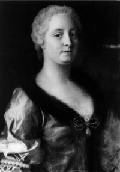
Empress Maria Teresa |
With the death of Emperor Karl VI the male line of the
Habsburgs had died out. Karl's daughter Maria Theresia succeeded
her father as the Empress of the patrimonial lands, the
Pragmatic Sanction (which had been issued in 1713 as a dynastic
measure, mainly to ensure the indivisibility of the lands)
allowing for female succession. The young Empress, who married
Franz Stephan of Lorraine, found herself faced with an array of
enemies who were seeking to seize the Habsburg lands. The
Prussian King Frederick II in particular spared no effort to
gain possesion of this heritage. Maria Theresia had to fight two
arduous wars (the Silesian War, 1740-1748, and the Seven Years'
War, 1756-1763) in order to retain her lands intact, with the
exception of the rich province of Silesia which she lost to
Prussia. |
|
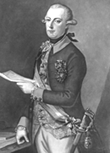 Emperor
Joseph II Emperor
Joseph II
|
Maria Theresia's husband, who had been elected Emperor of the
Holy Roman Empire in 1745 as Franz I, was overshadowed by his
wife's personality for all of his life. The great Empress
implemented a program of sweeping reforms in her lands. The new
system transformed the agglomeration of lands which had hitherto
been only loosely connected into a tightly administered
centralized state. Maria Theresia showed considerable skill in
choosing her statesmen and counsellors and was thus able to draw
on a team of outstanding experts. Wenzel Prince Kaunitz was in
charge of Austria's foreign policy; Wilhelm Count Haugwitz was
responsible for the domestic reform program; Gideon Count Laudon
set up a strong and efficient army. Reforms in the fields of
science and education were formulated in a spirit of Enlightened
Absolutism. |
|

Mozart's Family
|
Maria Theresia's son, Joseph II, abolished serfdom, issued the
Toleration Edict and secularized monasteries and church
property, thus paving the way for a consistent centralism.
Under the rule of Maria Theresia and her son Joseph II the
Habsburg court was a center of musical life. Christoph Willibald
Gluck, Joseph Haydn and Wolfgang Amadeus Mozart composed their
main works in Imperial Vienna. |
¡@
¡@
REVOLUTION AND RESTORATION
The ideas of the French Revolution, which - although tentatively -
also gained ground in Austria, represented a serious threat to Austrian
absolutism. Emperor Franz II, grandson of Maria Theresia and nephew of
the executed French Queen Marie Antoinette, joined the coalition against
revolutionary France. Napoleon conducted several campaigns in which
Austria suffered severe defeats.
After Napoleon had crowned himself Emperor of France in 1804, Emperor
Franz responded by institutionalizing his Austrian emperorship. The
establishment of the Conferederation of the Rhine under the auspices of
France led to the disintegration of the Holy Roman Empire in 1806. Franz
II of the House of Habsburg renounced the Imperial crown and continued
to rule as the Austrian Emperor Franz I.
In his subsequent campaigns Napoleon inflicted devastating defeats upon
Austria and even conquered Vienna twice. Archduke Carl's victory over
the Corsican at the Battle of Aspern had shown, however, that Napoleon
was not invincible.
The Congress of Vienna, presided over by the Austrian State Chancellor
Prince Clemens Wenzel Lothar Metternich, the "Coachman of
Europe." restored the old order in Europe.
The first half of the 19th century was marked by immense technical
progress. Originating in Britain, the steam engine conquered various
sectors of industry. The railway radically changed the transporation
system, and innovative machinery led to the emergence of many new
industries. The vast majority of the urban population worked in
factories, and the working class came into being.
THE MIDDLE CLASS REVOLUTION OF 1848
Originating in France, the ideas of the middle-class revolution reached
Austria in the spring of 1848. The liberals demanded a constitution and
freedom of the press. Metternich's hated police state was swept away,
and Metternich himself resigend and fled to England. In October 1848,
however, the revolt was suppressed, and the conservatives made a clean
sweep.
The successor to Emperor Ferdinand, young Franz Joseph I, established a
neo-absolutist system. His dubious policy of neutrality during the
Crimean War (1854-1856) led Austria into a dangerous isolation within
Europe. Thus it had to face Sardinia, which was in alliance with France
and supported the Italian independence movements, alone. After the
defeats at Magenta and Solferino in 1859 Austria was compelled to give
up Lombardy and at the same time to yield to internal demands for a
parliamentary institution. It did so by issuing the October Diploma and
the February Patent.
|
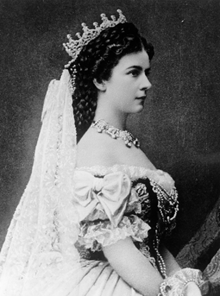 Empress
Elisabeth, wife of Emperor Franz Joseph I
Empress
Elisabeth, wife of Emperor Franz Joseph I
|
In the course of its conflict with
Prussia, which wanted to oust Austria from the German
Confederation once and for all, Austria suffered defeat at the
Battle of Königgrätz in 1866. In spite of the
successes scored in Italy at the same time, Austria had to
renounce Venetia in favor of Italy, which was striving for
national unification. Owing to the shrewdly conciliatory policy
of Prussian Chancellor Otto von Bismarck, Austria did not have
to pay territorial remuneration to Prussia but was finally
expelled from the German Confederation, thus losing all
influence on the further development of the German Empire. |
AUSTRO-HUNGARIAN DUAL MONARCHY
As regards domestic policy, in consequence of the defeat by Prussia,
Austria had to seek reconciliation with Hungary, whose rebellion in
1848/49 had been brutally suppressed with Russian help. In 1867 Hungary
became an equal member within a confederation which was held together by
the person of the ruler and explicitly defined common functions: foreign
policy, finance and military affairs.
|
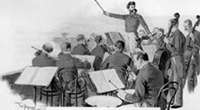 Johann
Strauss Band
Johann
Strauss Band
|
Political developments in the Austrian part of
the monarchy ("Cisleithania") were marked by the
development of the mass parties (Social Democratic Party and
Christian Social Party) and the demand for basic civil rights.
The first general elections by direct suffrage to the Imperial
Council (Reichsrat) were held in 1907. |
The long period of peace which lasted until the First World War was
safeguarded by a complicated system of alliances in Europe.
Austria-Hungary had joined up with the German Empire and Italy to form
the Triple Alliance. In addition to the smouldering European conflicts,
growing nationalism led to severe tensions within the multinational
Empire. The workers' justified demands for better pay and working
conditions fit for human beings were another problem which remained to
be solved.
During these relatively quiet years, the Austrian economy underwent a
process of rapid growth. The urban development of Vienna progressed
apace. The spirit of the "Gründerzeit" age found
expression in the newly constructed Ringstrasse in Vienna. Art and
culture at the turn of the century paved the way for modernism.
The assassination of the heir to the Austrian throne, Archduke Franz
Ferndinand, on June 28, 1914, in Sarajevo was only the immediate
occasion for the outbreak of the First World War. The European powers
confronted each other in a futile slaughter which lasted four years. The
outcome was decided when the United States entered the war. After the
defeat of the Central Powers (Austria-Hungary, the German Empire and
allied Turkey), the previous European order was shattered. The dual
monarchy disintegrated into nation states. The remnants were to form the
new Republic of Austria.
¡@
REPUBLIC OF AUSTRIA
"THE STATE WHICH NOBODY WANTED" AUSTRIA
1918 - 1938
One day after the last Austrian Emperor, Karl I, renounced the throne,
the delegates of the provisional national assembly proclaimed the
Republic of German- Austria and simultaneously union with Germany. After
the peace treaty (the new republic insisted on the term "state
treaty") was concluded, union with Germany was prohibited. The name
of the country was concluded to be merely "Austria". The
grievous loss of territory (South Tyrol and the Sudentenland) was to
some extent offset by the acquisition of Western Hungary (today's
Burgenland). The new republic found itself confronted with virtually
insurmountable problems, especially economic ones. At first the
successor nations refused to supply the most vital raw materials, so
that Vienna's population was on the verge of famine.
By the middle of the twenties, however, the Austrian government had
succeeded in stabilizing the currency and establishing functioning
beneficial economic relations with the neighboring states.
The internal political situation, however, became more and more
polarized; the various ideological camps opposed each other implacably.
The parties set up paramilitary organisations, and the "Republikanischer
Schutzbund" of the Social Democrats and the "Heimwehren"
which were closely associated with the middle-class bloc, fought fierce
street battles. The conflicts reached their first bloody climax when
political assassins were inexplicably acquitted and the ensuing
spontaneous demonstration was crushed in the most brutal manner. More
than ninety people died.
At the same time Austria began to feel the impact of the world-wide
economic crisis. Hundreds of thousands of jobless made the political
situation in Austria even more critical. More and more frequently the
right-wing bloc demanded the establishment of an authoritarian regime,
modelled after Italian fascism.
Thus in 1933 Engelbert Dollfuss, who was Federal Chancellor at the time,
used a minor impasse in parliamentary procedure to suspend Parliament
itself and to establish an authoritarian corporative state. The ensuing
political conflict within Austria - both the Social Democrats and the
Nazis supported by Germany put heavy pressure on the Government - ended
in a civil war and a coup d'état. In Febraury 1934 the Social
Democrats attempted a revolt which was crushed mercilessly. A series of
death sentences were passed. The workers were deprived of all
opportunities for political activity.
The abortive Nazi coup in July 1934, in the course of which Federal
Chancellor Dollfuss was murdered, was put down; the putschists were
tried before a military court.
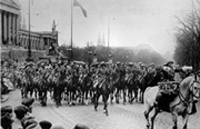
March 1938, German troops enter Vienna |
The new Federal Chancellor, Kurt Schuschnigg, sought to
maintain Austria as an independent nation by entering into an
alliance with Italy and Hungary. However, the German Reich,
which was already ruled by the Nazis and conducting a highly
successful foreign policy, put more and more pressure on the
Federal Chancellor. Schuschnigg's attempt to establish good
relations with Germany in a private meeting with Hitler in
February 1938 came to nothing. |
THE EXTINCTION OF AUSTRIA
Schuschnigg's Government made one last desperate attempt to maintain
Austria's independence by calling for a plebiscite. The German Reich
responded by setting ultimatums and with the invasion of German troops
on March 12, 1938. By that time, however, a considerable number of
Austrians had become adherents of Nazism. On March 13, 1938 Austria's
Anschluss to the German Reich was completed, and on April 10 of the same
year it was "legalized" by means of a plebiscite. The
Ostmarkgesetz (1939) erased the occupied country as a national entity;
the name of Austria was abolished.
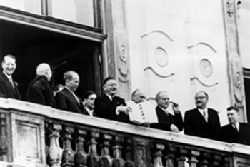
May 15, 1955, Fereign Minister Leopold Figl
holding up the State Treaty.
From left to right:
Llewellyn Thompson, John Foster Dulles,
Antoine Pinay, Leopold Figl, Adolf Scharf,
Vyacheslav Molotov, Julius Raab, Ivan
Iljitschov |
Shortly afterwards the Second World War broke
out, and all able-bodied male Austrians were called up. Even
before that, the Nuremberg Laws had been extended to Austria,
which was a disaster for the Austrian Jews. Of the 185,250 Jews
who lived in Austria in 1938, nearly 70,000 were killed in
concentration camps, almost all the others had to flee for their
lives.
They were not the only ones: many Austrians who joined the
resistance movement against the Nazi regime ended up in prisons
and death camps or were executed. |
END OF THE WAR AND LIBERATION
The resistance movements, which became more active toward the end of the
war, established contact with the Allied troops which were advancing
toward Austria to expedite the liberation of Austria. As early as April
27, 1945, the Provisional Government under Karl Renner declared
Austria's independence. It made explicit reference to the Moscow
Declaration of 1943 in which the restoration of an independent Austria
had been specified as one of the war objectives of the Allies. The
Allied troops which were advancing from the east, the south and the west
divided the country into four zones of occupation. Although there were
chaos and hunger throughout the country, the first free elections took
place as early as November 1945. They ended with a clear majority for
the democratic parties. Austria had once more become a nation which
enjoyed the full loyalty of its citizens.
A SOVEREIGN NATION AGAIN
Apart from economic reconstruction, the main goal of the Austrian
Government was the restoration of national sovereignty. Initial hopes
for the prompt signing of a peace treaty were soon shattered by the
East-West conflict and the beginning of the Cold War. The turning point
came only when the Federal Chancellor of Austria, Julius Raab, took the
initiative and introduced neutrality as a new element in the
negotiations. This finally led to the breakthrough in the Moscow
negotiations in April 1955. On May 15, 1955, the State Treaty was signed
in Vienna's Baroque Belvedere Palace.
On October 26, 1955, the Austrian Nationalrat enacted the Federal
Constitutional Law on the permanent neutrality of Austria. In December
of the same year Austria became a member of the United Nations, and in
the following years it participated frequently in UN peace-keeping
operations. Since 1979 Vienna has been one of the permanent seats of the
United Nations.
AUSTRIA JOINS THE EUROPEAN UNION
Already in the 60s, the Austrian Government tried to link Austria more
closely to the European Community. In 1967, Austria, a founding member
of EFTA (European Free Trade Association), negotiated with the European
Community but talks were broken off.
In 1972, Austria signed free trade agreements with the European
Community, thus abolishing all industrial tariffs.
Almost a year and a half before the fall of the Iron Curtain, on July
17, 1989, Austria filed its application for full membership in the
European Community, today's European Union. Shortly thereafter, Austria
joined the other EFTA members in negotiations for a free trade area
between the EFTA and EU countries, the so-called European Economic Area,
which became effective on January 1, 1994.
In 1991, the European Union had finally given green light for membership
negotiations with Austria. After more than a year of intensive talks,
the Austrians welcomed their results and Austria's adherence to the
European Union through an overwhelming vote. 66,56 % of the population
supported Austria's membership in the European Union.
On January 1, 1995, Austria became a full member of the European Union
together with Finland and Sweden. At the same time, Austria became an
observer in the Western European Union, the military arm of the European
Union. On February 10, 1995, Austria also joined NATO's
"Partnership for Peace" program.
As the first country of the new European Union member states, Austria
assumed the rotary Presidency of the EU on July 1, 1998 for the second
half of that year.
|

